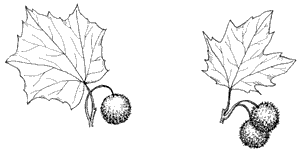London Plane Tree , (Platanus x acerifolia)
The London Plane is a hybrid of the American sycamore (Platanus occidentalis) and Oriental plane (Platanus orientalis). This handsome tree, belonging to the family Platanaceae, is particularly well adapted to urban conditions. This handsome tree needs plenty of space to grow and is suitable for large properties only. While London Planes tend to be as messy as their American cousins, dropping bark and fuzz balls all season, they are more resistant to disease.
London Plane trees typically grow from 70 to 100 feet tall and spread 65 to 80 feet at maturity. Growing at a medium rate, these trees will reach about 35 feet or so over their first 20 years. They have a pyramidal shape in youth but develop huge branches that open out as they age. As they grow, they shed their bark in large patches, creating mottled trunks of cream, tan, and olive green, a sort of camouflage pattern with brown flecks.
 |
| American Sycamore on left; London Plane Tree on right |
This tree have large, coarse, lobed leaves. Resembling maple leaves in shape, they have 3 to 5 sharply pointed lobes and may measure up to 6 to 8 inches long and 8 or 10 inches across. Sometimes they are broader than they are long.
They have smooth, dull medium green surfaces and paler undersides with hairy veins. They emerge in late spring, most dropping in December, although a few may persist until very late winter.
Male and female flowers occur on the same tree, usually on separate stems. This tree flowers emerge in late May or early June about the same time that the leaves show. Both male flower and female flowers are formed in round clusters about 1 inch in diameter and are yellowish-green and inconspicuous.
These clusters develop over the season into ball-shaped seed balls that are brown and fuzzy. About 1 to 1½ inches around, they are green at first, turning brown as the seeds within mature. These balls hang on the tree, two or three to a stalk, through the fall and much of the winter before beginning to shed the seeds in the spring. They are not attractive to wildlife.
London Plane Tree Choices
Bloodgood is a popular variety of the London Plane. It is a hybrid of the American sycamore and Oriental plane tree, also known as the American plane, and is particularly well adapted to urban conditions. Somewhat smaller than the American sycamore, it has slightly smaller leaves and a more greenish tinge overall. It bears its fuzzy fruitballs in distinctive pairs from a common stalk. The London Plane is one of the very few tree species that will survive in selected locations within all fifty states of North America.
Columbia or Liberty London tree varieties are also good options for the home landscape.
With its majestic presence and adaptability to urban environments, the London Plane tree remains a favored choice for large properties, parks, and city streets, where it can thrive and provide substantial shade. These trees, part of the genus Platanus, are not only aesthetically pleasing but also functionally beneficial in combating air pollutants. This widely planted species ensures that the tree grows successfully in various environments across the country.

